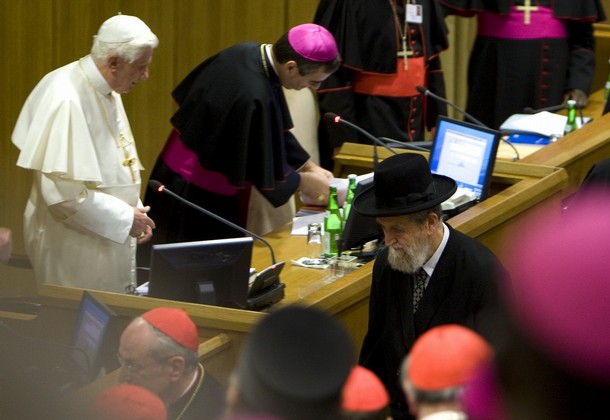 Was Cardinal Newman gay? Or (as the joke has it) simply divine? That was the controversy that dominated the dust-up over exhuming John Henry Newman, the great nineteenth-century English convert to Rome, in order to move his body to a more suitable location for veneration–that in anticipation of his beatification (the penultimate step to canonization) by Pope Benedict XVI next year.
Was Cardinal Newman gay? Or (as the joke has it) simply divine? That was the controversy that dominated the dust-up over exhuming John Henry Newman, the great nineteenth-century English convert to Rome, in order to move his body to a more suitable location for veneration–that in anticipation of his beatification (the penultimate step to canonization) by Pope Benedict XVI next year.
Newman, you see, had requested–indeed insisted, with his final breath–that he be buried in a grave at Rednal Hill cemetery outside Birmingham with Ambrose St. John, a fellow Oratorian who Newman described as the great love of his life. “I wish, with all my heart, to be buried in Fr Ambrose St John’s grave — and I give this as my last, my imperative will,” he wrote, “This I confirm and insist on.”
Many today thus insisted that removing Newman’s body from the grave would violate his last wishes as well as what they saw as a relationship that was more than Platonic–hence Newman was, improbably, becoming a gay icon of the twenty-first century. Andrew Sullivan–a gay English Catholic–“dished” on this argument here.
Not surprisingly, that argument sparked more than a bit of debate, and strong counterreactions. Those reactions may say more about a 21st-century American culture that is hinky about male friendships than it does about Newman. Still, theirs was an especially intense bond. Here is the English Catholic journalist Austen Ivereigh at “In All Things” on the relationship between Newman and St. John:
The two men loved each other deeply, had a life-long friendship, and lived together. And since Newman’s death in 1890 they have remained in the same grave in Rednal, about eight miles from Cardinal Newman’s house in Edgbaston, outside Birmingham.
In 1854 Newman wrote: “We have bought (I trust) a burying place — under the Lickey Hills, just about eight miles off — it is a most beautiful spot. . . . We are going to build a cottage there and ultimately a mortuary chapel.” They share a tombstone with the inscription “out of shadows and phantasms into the truth” etched across it.
Newman wrote after the death of St John in 1875: “I have ever thought no bereavement was equal to that of a husband’s or a wife’s, but I feel it difficult to believe that any can be greater, or anyone’s sorrow greater, than mine.”
The Cardinal -a hyper-sensitive, even delicate man — had intense friendships of the sort common in that age, especially in all-male bastions such as the clergy and Oxford.
But Ivereigh’s judgment that it is a bit much to consider the two men as a “couple” or “partners” in the modern, homosexual sense, seems about right, even if one must also consider the possibility that they were homosexually-inclined men who shared an intense if chaste relationship.
Is there anything wrong with that? A Newman biographer, Father Ian Ker, seemed to think so, penning a piece in the Vatican newspaper (CNS story here) in which he blamed the “homosexual lobby” for stirring up controversy (actually the first hurdle was a British law barring exhumation; that was eventually waived) and echoing a favorite line that celibacy can only be a sacrifice for a heterosexual not a homosexual because only a straight man is giving up marriage with a woman. “The only reason for which celibacy could be a sacrifice was that Newman, as every normal man, wanted to get married,” Ker said. Ker seemed on firmer ground with this point:
Nowadays there is no concept of friendship. In those days they had a concept of a loving friendship we have lost today,” he said.
“You no longer can say you love your friend,” he said. “But in those days people spoke quite openly of their love for their friends. Is this going to get to the point when fathers no longer can say they love their daughters? It is quite horrendous the implications of this nonsense.”
Alas, last week in a Geraldo moment (remember the safe opening from the wreck of the Titanic?) the gravediggers opened the tomb and…nothing! According to a church statement:
“Brass, wooden and cloth artefacts from Cardinal Newman’s coffin were found. However there were no remains of the body of John Henry Newman. An expectation that Cardinal Newman had been buried in a lead-lined coffin proved to be unfounded. In the view of the medical and health professionals in attendance, burial in a wooden coffin in a very damp site makes this kind of total decomposition of the body unsurprising. The absence of physical remains in the grave does not affect the progress of Cardinal Newman’s cause in Rome.”
It does quash the prospect of relics, at least of the first class. And what of the gay controversy? Austen Ivereigh again has the best epitaph to the whole affair:
There is something very Newmanesque about the end to this story. A shy, delicate, bookish man, he was never at ease with some of the aesthetic and ritual habits of the Church to which he spectacularly converted in 1844. The fact that there will be no lying-in-state, no marble sarcophagus to venerate, and no relics to distribute (beyond the few locks of hair that exist), seems hugely appropriate.
And how apt, in retrospect, seem the words of the epitaph which Newman and St John chose for their tomb: Ex umbris et imaginibus in veritatem — “Out of shadows and phantasms into Truth.”

